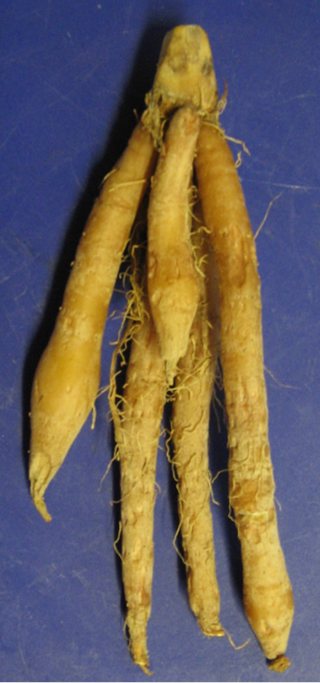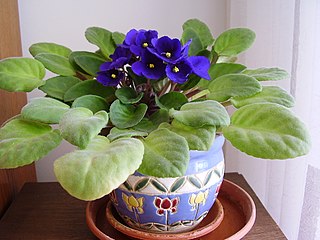
Boesenbergia rotunda, commonly known as Chinese keys, fingerroot, lesser galangal or Chinese ginger, is a medicinal and culinary herb from China and Southeast Asia. In English, the root has traditionally been called fingerroot, because the shape of the rhizome resembles that of fingers growing out of a center piece.

Saccharum is a genus of tall perennial plants of the broomsedge tribe within the grass family.

Hibiscus × rosa-sinensis, known colloquially as Chinese hibiscus, China rose, Hawaiian hibiscus, rose mallow and shoeblack plant, is a cultigen of tropical hibiscus, a flowering plant in the Hibisceae tribe of the family Malvaceae. It is an artificial hybrid created in cultivation in pre-European times by Polynesians in the west Pacific from the species Hibiscus cooperi and H. kaute. It is widely cultivated as an ornamental plant in the tropics and subtropics.

Gesneriaceae, the gesneriad family, is a family of flowering plants consisting of about 152 genera and ca. 3,540 species in the tropics and subtropics of the Old World and the New World, with a very small number extending to temperate areas. Many species have colorful and showy flowers and are cultivated as ornamental plants.

Trachycarpus is a genus of ten species of palms native to Asia, from the Himalaya east to eastern China. They are fan palms, with the leaves with a bare petiole terminating in a rounded fan of numerous leaflets. The leaf bases produce persistent fibres that often give the trunk a characteristic hairy appearance. All species are dioecious, with male and female flowers produced on separate plants although female plants will sometimes produce male flowers, allowing occasional self-pollination.

Amomum is a genus of plants containing about 111 species native to China, the Indian subcontinent, Southeast Asia, New Guinea, and Queensland. It includes several species of cardamom. Plants of this genus are remarkable for their pungency and aromatic properties.

The plant tribe Phaseoleae is one of the subdivisions of the legume subfamily Faboideae, in the unranked NPAAA clade. This group includes many of the beans cultivated for human and animal food, most importantly from the genera Glycine, Phaseolus, and Vigna.

Triadenum, known as marsh St. John's worts, is a small genus of flowering plants in the family Hypericaceae. The genus is characterized by opposite, blunt-tipped leaves and pink flowers with 9 stamens. They are distributed in North America and eastern Asia.

Elmer Drew Merrill was an American botanist and taxonomist. He spent more than twenty years in the Philippines where he became a recognized authority on the flora of the Asia-Pacific region. Through the course of his career he authored nearly 500 publications, described approximately 3,000 new plant species, and amassed over one million herbarium specimens. In addition to his scientific work he was an accomplished administrator, college dean, university professor and editor of scientific journals.

Elsholtzia ciliata, commonly known as Vietnamese balm, comb mint, xiang ru (香薷) or kinh giới in Vietnamese, is a flowering plant in the family Lamiaceae native to Asia. In the US, it is commonly known as Crested Late Summer Mint. In US Vietnamese grocery stores, it is called Kinh Gioi, Vietnamese Lemon Balm, or Vietnamese Lemon Mint.

Rheum officinale, the Chinese rhubarb, or Indian rhubarb is a rhubarb from the family Polygonaceae native to China. In Chinese it is called yào yòng dà huáng, literally meaning medicinal rhubarb.
Ligusticum striatum is a flowering plant native to India, Kashmir, and Nepal in the carrot family best known for its use in traditional Chinese medicine where it is considered one of the 50 fundamental herbs.

Buchanania is a genus of plants in the mango and cashew family Anacardiaceae, native to areas from India to southern China, and southwards to northern Australia and the western Pacific.
Flora of China is a scientific publication aimed at describing the plants native to China.

Cynomorium is a genus of parasitic perennial flowering plants in the family Cynomoriaceae. The genus consists of only one species, Cynomorium coccineum. Its placement in the Saxifragales was resolved in 2016 with the help of nuclear, plastid, and mitochondrial sequences obtained from next-generation sequencing. Common names include the misleading Maltese fungus or Maltese mushroom; also desert thumb, red thumb, tarthuth (Bedouin) and suoyang (Chinese). A rare or local species, it grows in dry, rocky or sandy soils, often in salt marshes or other saline habitats close to the coast. It has had a wide variety of uses in European, Arabian and Chinese herbal medicine.

Hypericum przewalskii, commonly called Przewalski's St. John's wort, is a flowering plant in Hypericumsect. Roscyna that is native to China.

Vitis bellula, commonly known as the beautiful grape or small leaf hair grape, is a Chinese liana in the grape family. It is native to the provinces of Guangdong, Guangxi, Hubei, Hunan, and Sichuan. The plant grows at elevations of 400–1,600 m (1,300–5,200 ft) and bears medium-sized purplish-black grapes.














